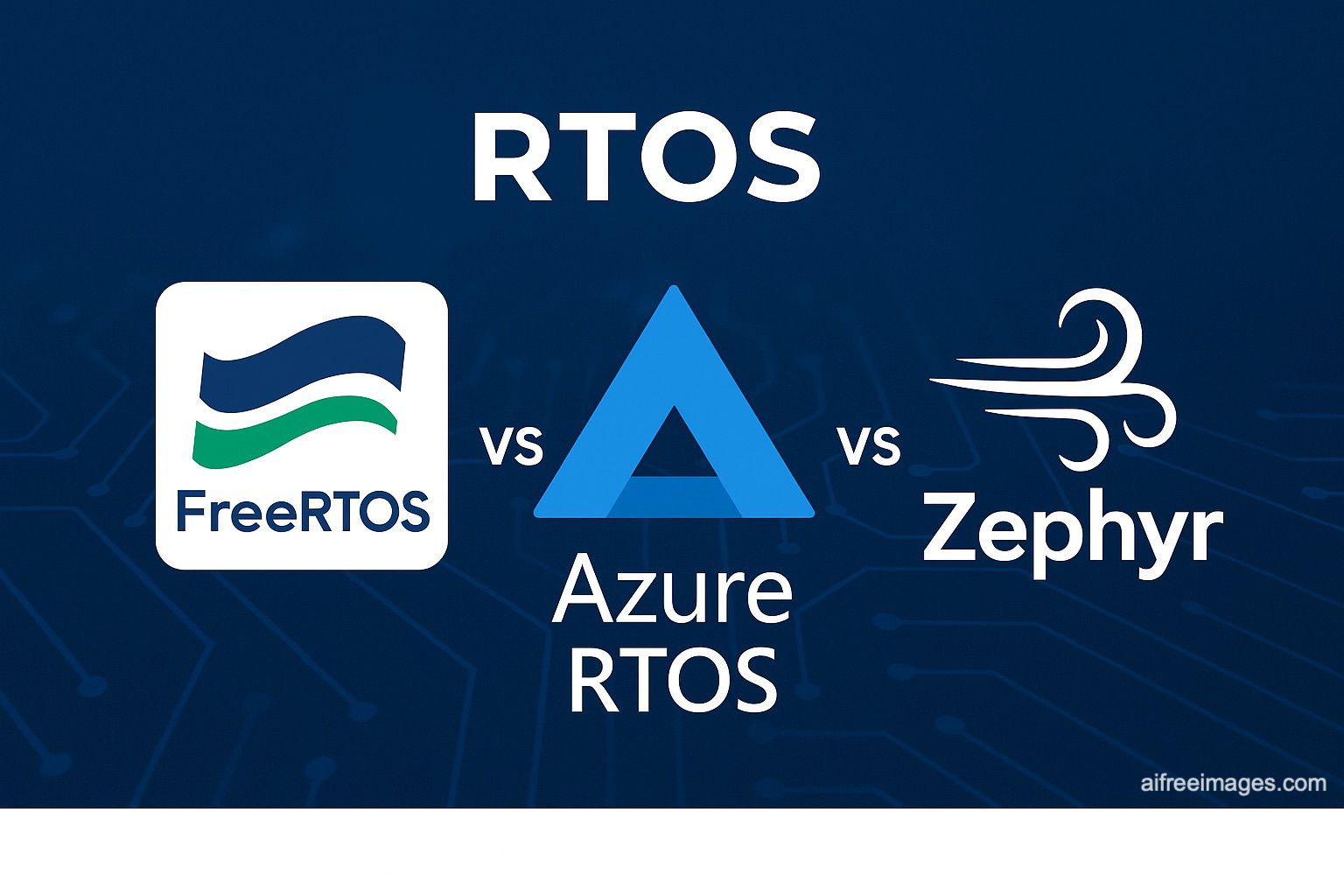We analyze the strengths, weaknesses, and use cases of the three main RTOSes in the market: FreeRTOS, Azure RTOS, and Zephyr. Which one to choose in 2025 for your next embedded project?
In the current connected device landscape, real-time operating systems (RTOS) have become critical components for developing IoT, industrial, medical, or automotive solutions. Among the wide range available, three stand out due to their maturity, support, and community: FreeRTOS, Azure RTOS, and Zephyr.
While all enable deterministic task execution with low latency on microcontrollers and SoCs, each reflects different philosophies, licensing models, and architectures. Below, we break down their main technical and implementation differences.
Overview and Origins
| Feature | FreeRTOS | Azure RTOS | Zephyr |
|---|---|---|---|
| Initial developer | Richard Barry (acquired by Amazon) | Express Logic (acquired by Microsoft) | The Linux Foundation (NXP, Intel, etc.) |
| Current maintenance | Amazon Web Services (AWS) | Microsoft | Linux Foundation |
| License model | MIT | Free commercial use license | Apache 2.0 |
| Main language | C | C | C |
| Focus | General / IoT / Low power | Industrial IoT / Azure IoT | Embedded / Industrial / Edge / Modular |
Main Technical Comparison
| Feature | FreeRTOS | Azure RTOS | Zephyr |
|---|---|---|---|
| RT kernel | Lightweight, preemptive | ThreadX, deterministic and robust | Modular kernel, optional tickless |
| SMP support | ❌ No | ❌ No | ✅ Yes (limited to specific architectures) |
| Scheduling | Round-robin and priority | Priority-based | Configurable priorities + SMP |
| Minimum RAM size | ~2 KB | ~2–3 KB | ~8–20 KB depending on subsystem |
| Supported architectures | ARM, RISC-V, MIPS, etc. | ARM Cortex-M (official) | ARM, RISC-V, x86, ARC, Xtensa, Nios II |
| Filesystem | FAT + optional third-party | FileX (FAT, exFAT, wear leveling) | LittleFS, FAT, NVS, Flash and SD support |
| Network support | FreeRTOS+TCP or lwIP | NetX / NetX Duo | Zephyr Net stack (IPv4/IPv6, TLS, CoAP, MQTT) |
| TLS / Cryptography | mbedTLS or wolfSSL | Built-in TLS with NetX Secure | mbedTLS, TinyCrypt, PSA Crypto |
| USB support | Device / Host (optional) | USBX (host/device/OTG) | USB Host/Device/OTG, CDC, HID, MSC |
| RTOS + Shell / CLI | Limited | Yes (ThreadX GUIX + optional shell) | Yes (Zephyr Shell, modular, scriptable) |
Cloud and DevOps Integration
| Feature | FreeRTOS | Azure RTOS | Zephyr |
|---|---|---|---|
| Cloud service integration | AWS IoT Core, Greengrass | Azure IoT Hub, Azure RTOS Studio | Optional, third-party modules |
| OTA updates | Supports AWS OTA Agent | Azure Device Update (ADU) | Zephyr DFU (MCUboot + OTA support) |
| Debugging / Tracing | FreeRTOS Tracealyzer, GDB | TraceX, SEGGER RTT | Zephyr Logging, Tracing, SEGGER SystemView |
Security and Certifications
| Feature | FreeRTOS | Azure RTOS | Zephyr |
|---|---|---|---|
| TrustZone (ARMv8-M) support | Partial, requires integration | ✅ Complete | ✅ Complete |
| Functional safety certification | IEC 61508, ISO 26262 (with partners) | Certifiable (ThreadX used in DO-178C, IEC 62304) | Partial (aimed to be certifiable) |
| Secure Boot / Root-of-Trust | Hardware dependent | Yes, with Azure Sphere / RT Secure Boot | MCUboot integrated |
Ecosystem, Tools, and Community
| Feature | FreeRTOS | Azure RTOS | Zephyr |
|---|---|---|---|
| Development environment / IDE | Any (VS Code, Eclipse) | Visual Studio, IAR, Keil | VSCode, Zephyr SDK, nRF Connect SDK |
| Community / Support | Very large (forum, GitHub) | Professional support via Microsoft | Active, diverse, backed by major corporations |
| Supported partners / SoC | Espressif, ST, NXP, Microchip… | ST, NXP, Renesas, etc. | Intel, Nordic, NXP, Laird, Adafruit, etc. |
| Simulator support | QEMU, Wokwi (limited) | Partial simulation | QEMU, Renode, Native POSIX port |
Which to choose in 2025? Recommended use cases
FreeRTOS: Ideal for simple projects, low power consumption, and high portability. Excellent for developers already working with AWS or needing a lightweight RTOS for 32-bit MCUs.
Azure RTOS: Excellent choice for industrial, medical, or critical apps needing enterprise support, robustness, and direct connectivity with Azure IoT.
Zephyr: The most modular, flexible, and powerful option for those seeking a modern RTOS supporting multiple architectures, open tools, and expansion into edge computing. Especially useful for projects with security, vision, BLE, or embedded AI requirements.
Conclusion
FreeRTOS, Azure RTOS, and Zephyr complement each other rather than compete. Each has evolved to meet specific needs within embedded and IoT sectors. FreeRTOS is known for its simplicity and widespread adoption, Azure RTOS for its industrial integration and reliability, and Zephyr for its ambition and ability to scale from sensors to edge gateways.
Ultimately, the choice depends on the hardware ecosystem, certification requirements, cloud deployment models, and long-term firmware maintenance strategy.
Sources: Official documentation of FreeRTOS, Azure RTOS, and Zephyr, GitHub repositories, AWS, Microsoft, The Linux Foundation, technical analyses from Embedded.com, and developer experiences from communities like Stack Overflow and Reddit r/embedded.

